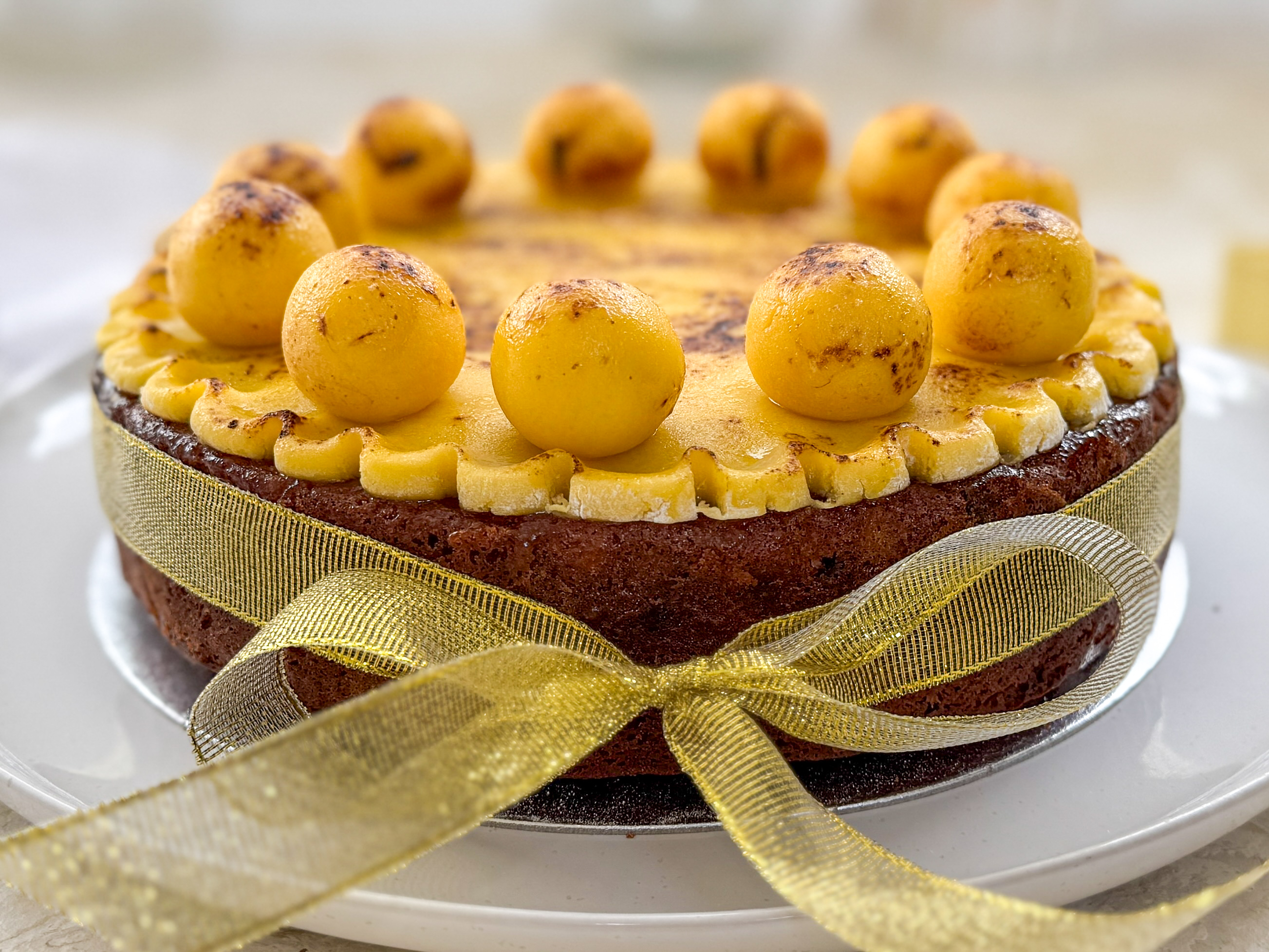
Bara Pasg – Easter Bread
Bara Pasg, translated as Easter Bread, is my version of a festive Bara Brith, dressed up as a Simnel Cake. If, like me, you haven't made a Simnel Cake, but you are looking for a last minute and quick alternative, this recipe could be your answer. Whilst lighter than a traditional Simnel, it comes together very quickly and can be eaten straight away. As a nod to Easter traditions, it is decorated in the same way as the classic cake, including the 11 marzipan balls which represent the 11 apostles. The marzipan in the centre melts into and infuses the cake, as well as helping to keep it moist. It is full of wonderful flavours and perfect if you have a houseful of visitors. Happy Easter!
Makes 3 x 20cm/8in round cakes
Ingredients
- 800g mixed dried fruit, e.g. sultanas, raisins, currants, glacé cherries, apricots, candied peel (*See Recipe Notes)
- 250g unsalted butter
- 560g milk
- 450g caster sugar
- 500g plain/all-purpose flour
- 4 teaspoons baking powder
- 5 teaspoons mixed spice
- ¾ teaspoon fine salt
- 4 eggs
- 2 teaspoons vanilla extract (optional)
You will also need:
- 3 x 500g packs of marzipan
- 4 tablespoons apricot jam
- 1 tablespoon water
- 1 egg white
Instructions
-
Collect together your equipment and ingredients. NB You need to start making this cake at least 1 hour before you want to bake it, to allow the fruit mixture to cool.
-
Make the cake: slowly bring the fruit, butter, milk and sugar to the boil and then simmer steadily for 2 minutes. Leave to cool for at least an hour. The milk solids may separate out – this is normal, don’t worry. It will come together when you bake the cake.
-
Grease and line 3 x 8 inch round cake tins. NB If you want to make only one cake, use the quantities in this recipe for Bara Nadolig.
-
Preheat oven to 170°C/325°F/Gas 3 (fan 150°C)
-
Weigh the flour, baking powder, mixed spice and salt to a large mixing bowl and stir to mix.
-
Add the eggs and vanilla extract to the dried fruit and milk mix. Mix well.
-
Sprinkle a work surface with icing sugar and using ⅓ of the marzipan, or 1 pack of marzipan, roll out 3 x 20cm discs of marzipan. Use the cake tin as a guide.
-
Pour the dried fruit and eggs on the flour and fold in. Mix thoroughly but do not over-mix.
-
Pour around ⅙ of the cake mixture (460g) into the base of each of the three prepared tins. I place the tins directly onto the weighing scales, one at a time, and pour in 460g of the cake batter per cake. Level the surface.
-
Cover each cake base with a disc of marzipan and then top with the remaining cake mixture. Again, I place the tins directly onto the weighing scales, one at a time, and pour in 460g of the cake batter per cake. Level the surface.
-
Cook in the centre of the preheated oven or 1 – 1¼ hours, until cooked and pale and golden.
-
When ready, remove from the oven, sit on one side for 10 minutes, remove from the tins and leave to cool on wire racks.
-
Top the cake: gently heat the apricot jam and water in a saucepan over a moderate heat. Mix well and then force through a sieve.
-
Sprinkle a work surface with icing sugar and using a further ⅓ of the marzipan, or 1 pack of marzipan, roll out 3 x 20cm discs of marzipan. Use the cake tin as a guide. Crimp the edges and brush off any excess icing sugar.
-
Place the cakes, upside down, on plates and brush the tops with the apricot jam. Cover each cake with a disc of marzipan.
-
Using the remaining marzipan, roll out 33 balls. 11 for each cake. Each ball should weigh 15g.
-
Use scissors to snip a tiny area off the bottom of each ball – this will help the balls sit on the cake without moving around.
-
Whisk the egg white with a fork to loosen it a little and use it to brush the surface of the marzipan.
-
Place the balls evenly around the edge of the cake and brush the top of these with egg white too.
-
Either:
- lightly caramelise the sugar in the marzipan using a blow torch.
or:
- place the cake under a preheated grill.
Watch it like a hawk – it will change very quickly and may burn if cooked for too long.
-
The cake is now ready to serve. Enjoy!
Recipe Notes
Equipment:
- 3 x 20cms/8in round cake tins greased and lined with parchment paper
- large saucepan
- large mixing bowl
- kitchen scales and measuring spoons
- cooling rack
- rolling pin
Dried Fruits:
Although traditionally made with mixed dried fruits such as currants, raisins and sultanas, you can use any dried fruit you like. I used apricots, figs, dates and glacé cherries. It is an ideal way to use up dried fruits which are slightly past their best – cooking them with the milk and butter really brings them back to life.